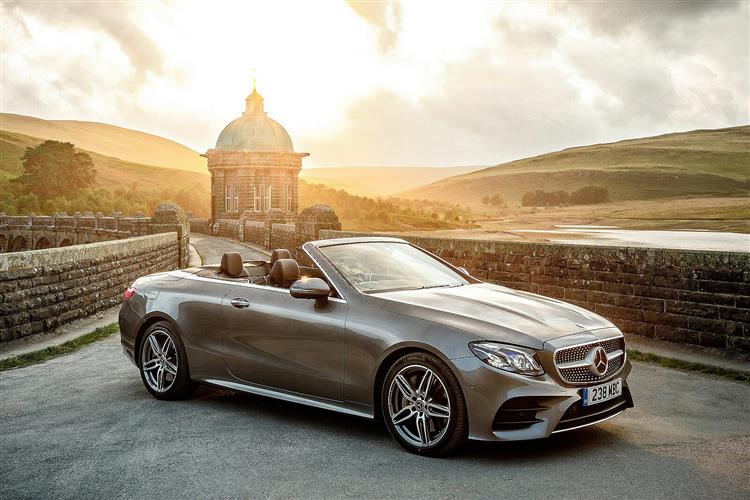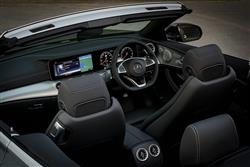How will you view?
This is a sample, showing 30 seconds of each section.
A MORE CREDIBLE CABRIOLET (some text hidden) SECTIONED_new_mercedeseclasscabriolet_2018
By Jonathan Crouch
Introductionword count: 107
This 'A238'-series Mercedes E-Class Cabriolet introduced in 2017 proved to be not only sleeker and more stylish than its predecessors but was also slightly larger and quite a lot more sophisticated. The result was an arguably more prestigious approach to Executive convertible motoring than obvious competitors from this period could offer. True, it isn't the sharpest steer in its class. Nor is it the most lavishly equipped or the most affordable to buy. But it's the best at being all the things that typical executive cabriolet owners want their cars to be. And yes, it feels a class above its rivals, just as a Mercedes-Benz always should.
Modelsword count: 19
2dr Cabriolet (2.0 diesel [E220d] / 3.0 diesel [E350d/E400d] / 2.0 petrol [E300] / 3.0 petrol [E400/E 53 AMG])
Historyword count: 433
The E-Class Cabriolet. It's a classic open-topped Mercedes that brings an extra touch of class to the executive drop-top sector. A very cultured convertible that's always aimed to set fresh standards for comfort and refinement in its segment. We're looking here at the 'A238'-series model launched in late 2017 which, like its predecessor, was primarily based on the E-Class Coupe and shared much the same engineering. What did change with this 'A238'-series model was the platform this design sat upon. It might sound strange to say it but this was the first E-Class Cabriolet in a very long time that had actually been based on an E-Class. This car's predecessor, the 'A207'-series E-Class Cabriolet launched in 2010, shared the more compact underpinnings of a smaller C-Class. As did the CLK Cabriolet model that cabrio replaced, originally introduced in 1999. In fact, prior to the launch of this car, you had to go all the way back to the old-school 'W124'-series model first introduced in 1991 to find an E-Class Cabriolet created like this one from the proper full-Executive sector underpinnings of an E-Class saloon. And that was important. Previous to the launch of this 'A238'-series design, an open-topped E-Class didn't really give you much more than you couldn't already get from a far more affordable C-Class Cabriolet. This one though, thanks to its newly acquired chassis, claimed to be quite a different proposition, supposedly big enough to offer proper rear seat and boot space for four adults. Plus its sophisticated insulated fabric roof was borrowed from the exotic Luxury segment S-Class Cabriolet. In short, on paper at least, it was at last a class above, not only its smaller open-topped stablemate but also the BMW 4 Series Convertible and the Audi A5 Cabriolet models that had pillaged sales from the previous generation model. There was more too, this 'A238'-series E-Class Cabriolet equipped with a whole raft of fresh technology that its predecessor couldn't have dreamed of providing. Probably the most significant addition was the new 2.0-litre four cylinder diesel powerplant that the vast majority of customers for this variant chose. And there was also plenty else that was new to this model line; 4WD, air suspension, all-new infotainment technology, sophisticated safety systems and cutting-edge assistance features that allowed owners to take a step closer to fully autonomous driving. Plus with this 'A238'-series design, Mercedes put greater effort into giving this variant a sportier feel. This car sold until mid-2020, when it was substantially facelifted. It's the pre-facelift 'A238'-series versions of it though, that we're going to look at here for the used market.
What You Getword count: 510
Since this 'A238'-series E-Class Cabriolet was able shed the previous model's compact C-Class underpinnings, it was able to grow a little. Well quite a lot actually, this generation design being 123mm longer, 74mm wider and 30mm taller than its predecessor. We should start by telling you a little about the fully automatic roof, which features an acoustic design derived from that used by the brand's larger S-Class Cabriolet. You activate it via the middle button in a trio of switches ahead of the central armrest and the opening - or closing - process takes 20 seconds, with operation possible at speeds of up to 31mph. A particularly nice touch is the way you can also activate the roof mechanism using the key fob. So if you're across the street from your E-Class Cabriolet sipping a coffee and admiring the car in its roof-retracted form, then the heavens open, you can casually raise the hood without shifting from your seat. Brilliant. When retracted, the folded canopy is stored in its own boot compartment, separated from the rest of the trunk by a retractable cover. As for the other two switches either side of the main control button between the front seats, well one retracts all four windows in one action, while the other engages the 'AIRCAP' draught-stop mechanism which raises a rather ugly contraption on the windscreen header rail at the same time as activating an equally awkward-looking wind deflector behind the rear seats. Both features are undeniably effective though. Take a seat inside and Mercedes' now traditional 'belt butler' hands you your seatbelt over your shoulder on an extending arm, a nice little touch that really sets the tone for this car. Take a look around and you'll find that, as expected, apart from a few extra trimming panels, the basic architecture of the cabin is shared with the E-Class Saloon, the only really unique difference being the more distinctive air vents - there are no fewer than four of them in the centre of the fascia, all with styling that's supposed to echo the look of a turbine engine. The other main cabin talking point is the double-screen instrument panel which was standard on six cylinder models but optional on four cylinder variants. It combines a 12.3-inch virtual instrument display with a second centre-dash 'COMMAND Online' monitor of the same size, both screens fitted into a single frame. Once you're in the back, there are certainly signs of improvement over the previous generation model. The 113mm increase in wheelbase does indeed translate into extra stretching space - there's 103mm more knee room. Plus thanks to 74mm of body width, there's 34mm more space for your shoulders. And boot space? Well, with the roof open, the luggage capacity is 310-litres. With the roof up, that capacity figure rises to 385-litres. Should you want to carry more, the standard 50:50 split-folding rear backrest can be activated via two buttons on either side of the cargo bay, creating the option for you to push through longer items like skis or golf clubs.
To see the full road test text contact us on 0330 0020 227
Pictures (high res disabled)

.jpg)
|
.jpg)
|
.jpg)
| |||
.jpg)
|
.jpg)
|
.jpg)
| |||

|
Scoring (subset of scores)
Category: Convertibles
| Performance | |
| Handling | |
| Comfort | |
| Space | |
| Styling, Build, Value, Equipment, Depreciation, Handling, Insurance and Total scores are available with our full data feed. | |



